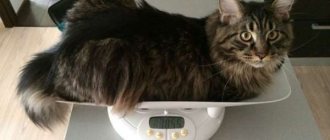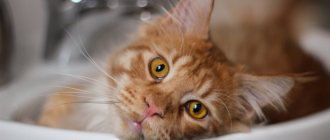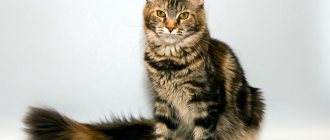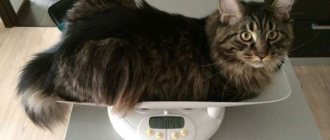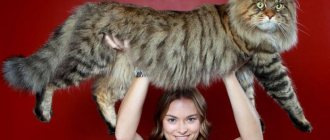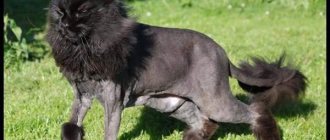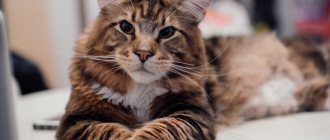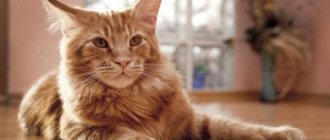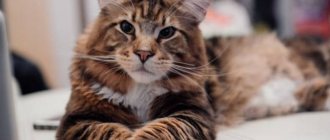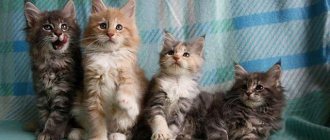Maine Coons know how to make an impression with their appearance - gigantic size, beautiful hair, tufted ears, powerful paws, dressed in “pants.”
At first glance, it may seem that these domestic lynxes require special living conditions. In fact, caring for a Maine Coon is not difficult if you know the habits of these animals and follow simple rules. The coon should not be kept in a small apartment - it is a large, active cat that requires living space, if only due to its rather large size. Animals of this breed are not cheap to keep, primarily due to the cost of food - Maine Coons require more of it than ordinary cats, but in general they are unpretentious, have good health and an easy-going character, which is important when caring for them.
Why are there no tassels on the ears?
People who want to become Maine Coon breeders are afraid to buy kittens without brushes, believing that they will be given a “damage” and not without reason, given the price for one baby. The bottom line is that the lack of sharp woolly ear tips is common in the breed. It is considered more of a norm than a deviation, and cats with an “anomaly” are allowed into exhibitions and competitions.
It is impossible to determine in advance whether Maine Coons have brushes. Genetics are designed in such a way that even mom and dad with tassels will not give a 100% chance of such a kitten appearing.
Features of the structure of the ears
The Maine Coon is rightfully considered unique among domestic cats; its head anatomy is similar to its wild relatives - the lynx. Wide, open, triangle-shaped ears with a cluster of hair at the tip are the hallmark of the Coon. The space between the ears does not exceed the length of the base of the ear, the shells are recessed. The surface of the internal cavity is delicate and pinkish, protected by a copious layer of thick hair. The structure of the muscles allows the ears to be sharply pressed to the head. The upper edge of the auricle begins slightly above the outer corner of the eye or at its level. A scruff grows around the head.
Does everyone have brushes?
Whether tassels will appear on your pet’s ears also depends on the diet, which must contain meat.
The genetics of the species suggests deviations from the norm, and the rules of competitions allow participation without brushes, equating both in determining authenticity. The absence of tufts on the ears of a Maine Coon in the first months of life does not mean that the kitten will not grow the treasured hair growths. This is facilitated by regular balanced nutrition according to all the rules of care and, of course, meat.
When do tassels appear?
Kittens of this breed acquire tassels for 5-6 months. life, there have been cases of delays of up to 9-10 months. This is due to the genetic characteristics of the parents and the ancestral line. Absence is possible due to a family member in the older generations. It is impossible to determine in advance which kitten will grow up and whether tassels will appear. New breeders are afraid to take on an animal without the hallmarks of a “real” breed.
This is interesting: Toilet for Maine Coon
Dimensions of a Maine Coon kitten at birth
According to observations, buyers usually strive to purchase the largest kitten from the litter. However, its size at birth may vary. For example, the average weight of a newborn Maine Coon is 150 grams (while the weight of a regular kitten is 70-80g).
The size of a newborn baby can also be affected by:
Floor. Boys are usually born larger than girls. If a boy in a litter weighs 160g, then a girl weighs 130g.
Number of kittens in the litter. If a cat gives birth to one cub, it can reach a weight of 170 grams, while when 4-5 kittens are born, their average weight will not exceed 140 grams.
Parents' size. The larger the baby's parents, the more he will weigh at birth. By the way, looking at the appearance of your future pet’s mom and dad, you can roughly imagine what your Maine Coon will look like.
Purebred breed. The admixture of cats of other breeds also affects the size of the kitten. It may be significantly smaller than normal size.
Hormonal therapy. If a cat was given hormonal drugs during pregnancy, this could affect the weight of the resulting litter.
Stress. Cats that have experienced a shock, such as separation from their owners or moving to a new place of residence, can also give birth to smaller kittens. By the way, this will also affect their further growth.
How to comb
Maine Coons have long coats that require special care. For this procedure you will need one or two combs with sparse and fine teeth. The tips of the teeth should be blunt and not sharp. It is also advisable to have a comb with long, sparse and rounded teeth, as well as a massage brush. You can use it to brush your cat before shows. The massage brush should also be used during the shedding period.
First, combing is carried out with a comb with sparse teeth, then with fine teeth. You need to comb in the direction of the fur. For convenience, you can divide the wool into partings. It is not recommended to scratch the neck area, hind legs and tail with a fine comb, as the hair there takes a long time to recover.
Long, thick fur sometimes develops tangles. They usually cluster on the chest, belly, hind legs, behind the ears and in the lower neck area. The tangles cause anxiety for the cat. They tighten the skin when wool is wrapped around the tangle. It must be divided into several parts and combed out. If this cannot be done, then you can carefully cut it off with nail scissors or tweezers. To do this, pull the tangle towards you and cut off the hairs directly under it.
It is better to brush your Maine Coon no more than four to five days. Brushing prevents severe hair loss and massages the hair. It is advisable to train your pet from an early age.
Does size matter?
You can find all sorts of tips for adding tassels to your coon ears. The most popular of them:
- thin out with tweezers at a certain molting period;
- trim the ends with scissors;
- lubricate the hairline with castor, burdock or olive oil, or even medicinal ointment or eyelash growth product.
Most often, such manipulations do not lead to anything other than stress for the animal, because the size of the hands depends only on the genetics of the Maine Coon.
It happens that a kitten has large tassels, but when he grows up, they remain medium in size, or even small. It's all about the individual characteristics of each animal. It is often advised to take vitamins to improve the condition of the coat - maybe the Maine Coon's brushes will not become giant, but this will not harm the health of the pet. Many coon fans fell in love with this breed because of its lynx ears, but even a brushless Maine Coon never ceases to be a charming animal, which is loved not for the decoration on its ears, but simply for the fact that it exists.
Prevention is the key to health
Caring for a Maine Coon primarily involves caring for the pet’s health. Coons, like cats of other breeds, must be vaccinated once a year against rabies, calcivirosis, panleukopenia and rhinotracheitis, and also periodically treated against ticks, fleas and helminths. Even if the animal does not leave the house, parasite larvae can be carried on the soles of shoes, and if the cat is taken to the country or it often participates in exhibitions, vaccination and deworming are vital for it.
Useful to read: Features of houses for Maine Coons
Maine Coons need vitamins for a healthy, beautiful coat, strong bones and teeth, and to maintain immunity. It is especially important that your pet receive vitamin supplements during growth, pregnancy, or illness. Special vitamin complexes for cats have been developed and can be purchased at veterinary pharmacies.
Feeding your cat pills is a problem for many Maine Coon owners. Animals spit out the medicine, and if it is mixed with a treat, they manage to eat the food and bypass the tablet. In this case, the medicine is turned into powder and combined with liquid food. If this does not help, there is only one way out - put the tablet in the cat’s mouth, on the root of the tongue, close its jaws with your hand and hold them until the animal swallows the medicine.
In addition, clean semi-long-haired Maine Coons need a special paste for removing hair. While licking itself, the Maine Coon swallows fur, it gets into the stomach, rolls into hair balls there and causes discomfort to the animal, leading to constipation, coughing, and even intestinal obstruction. The paste helps solve this problem, especially during shedding. It can be mixed with food, or it can be given to the cat separately.
If the kitten is not gaining weight
Typically, a similar problem occurs when the coon is not fed correctly. Perhaps the kitten simply does not have enough food that its owners give it. Still, this is a rather large cat. Try to gradually increase your diet and record the results in your diary every day (it’s better to weigh your cat on an electronic scale).
It is possible that the inhibition of weight gain is due to a lack of certain nutrients. This happens especially often with calcium deficiency. In any case, to find out the reason, it is better to take the kitten to a veterinary clinic and undergo an examination.
By the way, practice shows that owners who feed their pets dry food are less likely to encounter weight problems. But those who strive to feed their pets homemade food often experience problems with the balance of nutrients.
Therefore, listen to the recommendations of veterinarians, get vaccinations on time and regularly come for examination with your ward. Compliance with all the rules and recommendations will allow you to raise a beautiful, and most importantly, healthy Maine Coon!
Source
Nutrition - what and how to feed?
Proper feeding of Maine Coons is an important part of a cat’s healthy life. It is important to choose the right food and water containers for your pet.
It is necessary to take into account the fact that in the wild, the ancestors of cats, before drinking, try to clear the surface of the water from debris, fallen leaves, and twigs. At the same time, water is sprayed in different directions. Pets have retained this reflex. The Maine Coon may even knock over a bowl of water or move it along the floor. Therefore, the drinking container should be moderately heavy or fixed to the floor so that it does not move and cannot tip over.
The food bowl should be kept away from the water container. Otherwise, splashes that get into the food bowl can ruin the food. If the cat stays at home without its owners for a long time, it is better to purchase a water bottle. Water should always be fresh and clean.
Feeding Maine Coons has its own rules:
- You only need to feed your cat dry food of premium quality. It contains the necessary vitamins and various nutritional supplements that are important for the health and normal development of Maine Coons. Can be combined with canned food;
- if you feed with natural food, then the basis of the diet (at least 80%) should be meat and dairy products, vegetables and grains;
- If the cat's diet consists exclusively of natural products, it is necessary to regularly give vitamins;
- with a mixed diet, dry food should be the basis, and natural food should be additional.
What natural products can you feed your Maine Coon:
- meat: poultry, beef (raw and cooked), rabbit, lean lamb, chicken livers and hearts.
- vegetables: carrots, beets, cabbage, cucumbers, zucchini, pumpkin, tomatoes;
- hard cheese;
- eggs: yolk once or twice a week, boiled or raw;
- boiled sea fish, seaweed and other seafood;
- cereals, bran;
- fermented milk products: cottage cheese, yogurt, kefir, fermented baked milk (milk can only be given to kittens under 3 months of age);
- cereals: three to four times a week as an addition to boiled meat;
- sprouted grains: wheat and oats.
Important! It is prohibited to add salt, sugar, or spices to cat food.
It is strictly forbidden to give your pet beef and chicken bones, fatty pork, duck, goose, smoked meat products, sausages, sugar, potatoes, legumes, and chocolate.
Cats need to eat fresh greens periodically. To prevent your pet from being drawn to dusty, dirty grass during a walk, you need to sow grass seeds (wheat, oats) in a low, wide container (box) at home and allow the cat to eat the young sprouts.
If a cat is allergic to any of the food or products, the allergen should be removed from the diet.
Cat food should not be hot or cold. It should be at room temperature. Kittens need to grind their food. The kitten should eat at least 5 times a day. This principle must be maintained for up to 2 months. From six months onwards, the frequency of feedings is reduced to three times a day, and eight-month-old cats should be switched to two meals a day.
This is interesting: Photos of tortoiseshell Maine Coons
Periods of development of a Maine Coon kitten
In general, the development of a Maine Coon kitten goes through 4 periods until it reaches adulthood:
1. Neonatal. This is the period of the first days of a newborn mole rat’s life, when it feeds exclusively on mother’s milk, and its weight gain is largely determined by the severity of the cat’s birth.
2. Suction. This includes the first month of the kitten's life. At this time, he actively feeds on his mother’s milk, gaining 20-30g in weight every day.
3. Transitional. The name of this period clearly indicates that the matured kitten learns to feed on its own. The transition period covers the second month of a kitten’s life, and its weight gain becomes less (10-20g per day).
4. After suction. This is a long period of time, starting from the age of two months and ending with the full adulthood of the Maine Coon. It is characterized by the kitten's weaning from its mother and the transition to independent feeding. At this time, the baby is actively gaining weight and this process actually continues up to 3 years.
Pet health - maintenance and care
Caring for a pet primarily involves paying attention to its health. To prevent your cat from getting sick and live a full life, it is necessary to take preventive measures. A domestic cat can catch the disease not only on a walk, but also at home. Infection or parasites may be brought in by shoes.
Prevention:
- once a year you need to be vaccinated against rabies, panleukopenia, calcivirosis, rhinotracheitis, chlamydia, infectious peritonitis, trichophytosis and microsporia (ringworm);
- treat wool with flea and tick preparations;
- take anthelmintics.
Maine Coon kitten: stages of growth and maturation
More and more people want to get themselves not just a cat, but the largest cat in the world - the Maine Coon! We agree that this has its own charm, because a domestic cat, which is several times larger than its fellow cats, inevitably attracts the eye and causes admiration.
But in order for a handsome Maine Coon to charm those around him with his appearance, he needs to be raised from a small kitten, and this is not at all easy.
In this article we will talk about the stages of growing up of Maine Coon kittens, as well as about the problems that the owners of such pets risk facing.
Bathing a raccoon cat
Bathing is an important part of Maine Coon care. Like all cats, representatives of this breed are not too fond of water treatments that involve getting their fur wet, although they enjoy playing with water. Coons are washed once every few months; urgent bathing is recommended if the pet is dirty or shedding (washing speeds up the shedding process - dead hairs are easier to remove). You should definitely bathe the animal before the exhibition.
For water procedures, you need shampoos (washing and tinting), conditioner, sponge, towel, hair dryer, as well as hair styling products (gels, creams, powders).
Bathing a Maine Coon goes like this:
- Fill a sink or small basin with warm water (not lower than +38°C). You can put a terry towel on the bottom so that the paws do not move apart and the cat does not get nervous.
- Holding the Maine Coon by the scruff of the neck, moisten the fur with a sponge and gently rub shampoo intended for long-haired cats into it, from the back to the tail.
- The cat should never be rubbed, otherwise the fur will become matted.
- Wash your hair without shampoo, do not allow detergent to get into the animal’s mouth, eyes and ears.
- You need to wash your Maine Coon's fur under a weak shower, from head to tail. Be sure to remove all the shampoo to make the coat squeak, otherwise skin irritation may occur. In addition, if the wool is poorly washed, it appears unkempt.
- Apply a special conditioner to the cat's fur, then rinse it thoroughly.
- Dry the animal with a towel, maybe a paper towel, so that the long fur does not get tangled from wiping.
- Wrap the Maine Coon in a large towel and take it to a warm, draft-free room.
- Dry the fur with a hairdryer (if the cat can tolerate the sound of it).
- Brush the cat. Pay special attention to the belly and “pants”, where the fur tends to curl in ringlets; it is advisable not to comb the tail at all, and comb the collar from bottom to top for fullness.
Development of a Maine Coon kitten by month
• 1st month. Immediately after birth, the kitten arrives in stress and gains very little weight. However, then he goes into a routine, starting to eat actively and steadily gain about 20g per day. It is not surprising that by the first month of life the baby exceeds its original weight by almost 4 times. Maine Coon boys weigh about 800g, and girls about 600g.
• 2 months. The baby continues to feed on mother's milk in the same mode, and therefore the weight increases proportionately. As a result, by the second month of life, boys of this breed weigh 1600 grams, and girls - 1400 grams. However, at this time you can already begin to introduce complementary foods to your baby. This can be boiled meat pureed, baby yoghurts or cottage cheese.
In addition, the kitten is already ready to learn everything new. He masters the tray and enjoys playing with toys. The mother cat plays a huge role in teaching the baby, teaching the baby the rules of behavior, in particular, showing how and where to sharpen its claws.
• 3 months. A three-month-old kitten can be gradually weaned off its mother's milk. The baby is already quite ready to consume dry and wet food, and should eat 4-5 times a day.
In addition, by the age of three months, the little Maine Coon must visit a veterinary clinic and receive all the necessary vaccinations, as well as a veterinary passport.
• 4 months. Around this period, the young Maine Coon finds new owners and moves to a new home. These events become stressful for the animal, and therefore it is possible that the kitten begins to gain weight more slowly. At the same time, the pet goes to the toilet tray without prompting and can be trained.
• 5 months . By the age of five months, the Maine Coon transforms from an angular kitten into a beautiful purebred cat. Its weight, depending on gender, varies between 3-5 kilograms. Growth at this age slows down somewhat, but weight continues to increase.
• 6-9 months. By this period, the cat's baby teeth fall out and permanent teeth appear. Therefore, more foods with calcium (boiled fish, fermented milk products) should appear in his diet. And by this age, the Maine Coon begins to be given frozen meat periodically. To do this, beef cubes are simply frozen in the freezer for a couple of days and given to the cat as a treat.
Eyes, ears, teeth and claws - these are my documents
It is advisable to regularly inspect your Maine Coon's teeth to ensure that tartar does not form. If your cat eats dry food, you can brush its teeth once every two months; if it eats natural food, you can brush its teeth at least once a month. Coonam's teeth are cleaned with a special paste for cats using a children's toothbrush.
Caring for the eyes of a healthy cat is usually limited to daily wiping with a piece of cotton wool. If discharge appears, you can wipe your eyes with tea or a weak solution of boric acid.
The inside of a large weasel ear should be pink, clean, and free of black coating. If wax builds up, it can be gently removed with a cotton swab and Vaseline.
Useful to read: How to choose a suitable tray for Maine Coons?
If the Maine Coon is not supposed to be present at the exhibition today or tomorrow, it is better not to touch the claws - he will take care of their length himself using a scratching post. But if the claws have grown a lot, they can be trimmed with a special nail clipper or tweezers, very carefully, cutting off only the tip, strictly across, otherwise you can hit a blood vessel.
Particular care must be taken in shortening pigmented claws - the blood vessels are not visible through them, in addition, it should be remembered that the claws on the front paws are longer than on the hind paws. It is better to carry out the procedure together - one person holds the cat, and the other shortens the claws. After this cosmetic operation, you can polish the claws with a nail file. If an animal breaks a claw, it must be trimmed: a broken end can injure the cat's paw.
An important feature of the breed
There are other breeds with tassels, such as Norwegian forest cats and pixie bobs. But a large part of the Maine Coon’s charm lies precisely in its large ears, decorated in a lynx style.
Even when choosing a kitten, it is recommended to pay attention to its ears, which is often understood unambiguously: if there are tassels, it’s a coon; if not, it’s a mixed breed or a mongrel kitten. In fact, they are not a mandatory attribute for Maine Coons. The breed standards state their desirability, but an animal with small tassels will in no case be disqualified. They are not a mandatory sign of a purebred animal, but they certainly make the coon more spectacular and “wild.”
Maine Coon kittens have ear tufts that are not very thick; over time, they grow back and become “lynx-like.” You should not expect that the kitten will instantly become the owner of lush hands - they grow slowly. The tassels of Maine Coons of the European type (extreme types) are often longer than those of the “Americans,” but extreme types are, in principle, larger than aboriginal coons, in addition, long tassels on the ears are “cultivated” by fans of “Europeans.”

